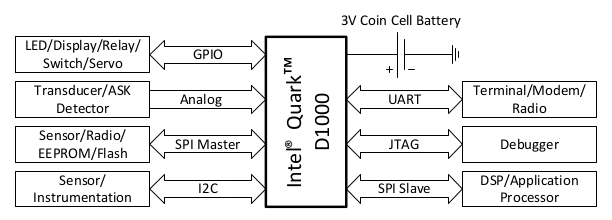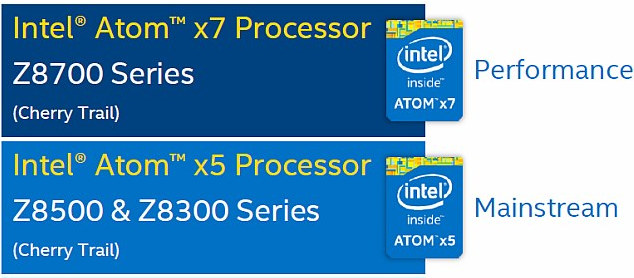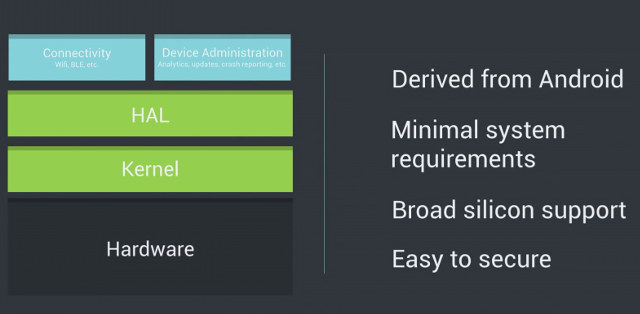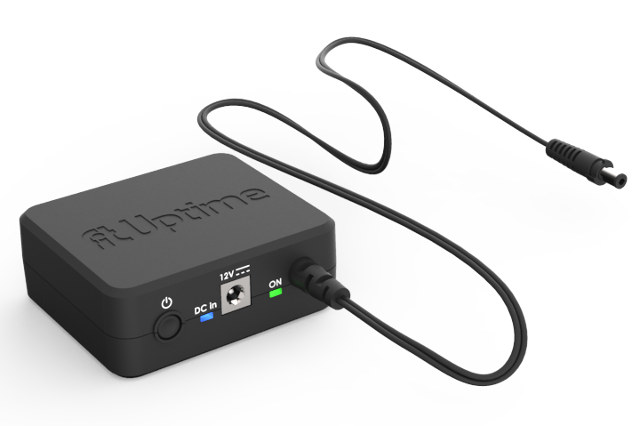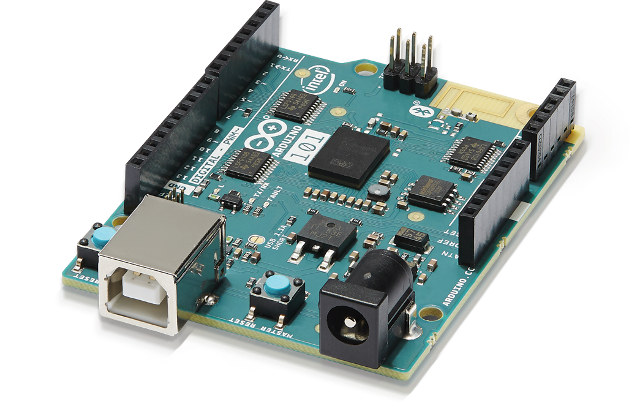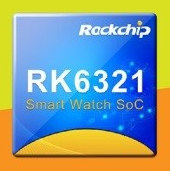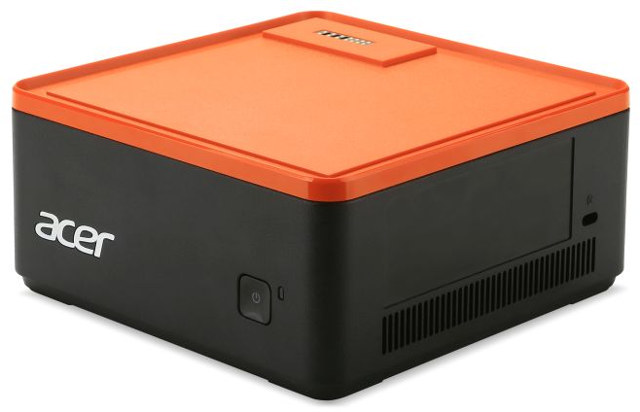Intel’s subsidiary, Wind River, has recently announced two operating systems for the Internet of things with Rocket RTOS and Pulsar Linux supported respectively by Quark MCUs, and Intel Atom processors, as well as some ARM SoCs. But it’s not the only “IoT” announcement made by Intel in the last week, as I found out via EETimes that the company also unveiled three new Quark SoCs, namely Quark D1000, and Quark D2000, and Quark SE. Intel Quark D1000 Contrary to previous Quark processor and the upcoming D2000 and SE processors, D1000 is not compatible with x86 instructions set, and features the following: 32-bit Harvard CISC CPU @ 33 MHz with single cycle barrel shifter, two cycle multiplier, multi-cycle divider, integrated 32-bit timer, programmable interrupt controller, and JTAG debugger. 128-bit wide 32 kB code flash and 8 kB ROM 32-bit wide 8 kB SRAM and 4 kB data flash Osciallators 20-33 MHz […]
Intel Introduces 3 “New” Atom x5 and x7 Processors, a GPU Naming Scheme
Intel has a published a product change notification regarding an update to Intel Atom x7-Z8700, x5-Z8500, and x5-Z8300 processors with the new Intel Atom x7-Z8750, x5-8550, and x5-Z8350 processors with higher CPU burst frequencies, and some graphics fixes (Alpha Blending and ASTC issues). The company has also come up with a naming scheme for the Gen8 GPUs used in the processors with the 12EU (Execution Units) SKU being called HD Graphics 400, and the 16EU SKU called HD Graphics 405. That means there are now 6 Cherry Trail processors: Atom x5-Z8300 quad core processor @ 1.44 GHz with 1.84 GHz burst frequency and HD Graphics 400 Atom x5-Z8350 quad core processor @ 1.44 GHz with 1.92 GHz burst frequency and HD Graphics 400 Atom x5-Z8500 quad core processor @ 1.44 GHz with 2.24 GHz burst frequency and HD Graphics 400 Atom x5-Z8550 quad core processor @ 1.44 GHz with 2.4 […]
Wind River Introduces Free Cloud-based Operating Systems for IoT Applications
After Google Brillo operating system was officially launched last week, another company has announced free operating systems for IoT. What’s peculiar is that the company is Wind River a vendor of commercial operating systems whose typical business model is to sell licenses for their operating systems and fees for their development services. Nevertheless, the company has now introduced Wind River Rocket real-time operating system, and Wind River Pulsar Linux operating system. Both OSes will interface with the company’s Helix Cloud software-as-a-service (SaaS) products, which is probably how the company intends to monetize their work, on top of customization services. Wind River Helix App Cloud is currently made of three products: Helix App Cloud cloud-based development environment for building IoT applications Helix Lab Cloud cloud-based virtual hardware lab for simulating and testing IoT devices and complex systems. Helix Device Cloud cloud-based platform for managing deployed IoT devices and their data. Some […]
Brillo Android based OS for IoT Projects Supports ARM, Intel and MIPS Platforms
You’d think there are already enough lightweight operating systems that could provide a good enough platform for IoT and embedded projects, but Google decided to make their own Brillo operating system for IoT, based on Android, most probably to leverage the existing Android tools, and make it easier for app developers to move to the Internet of Things space. Brillo ‘s hardware requirements are pretty low as the operating system can run on devices with 32MB of RAM, and 128MB of storage. Google will provide a complete ecosystem with an embedded OS, core services, and a developer kit with tools to build, test, and debug. Just like in Android, three architectures will be be officially supports, starting with the following hardware platforms: ARM – TechNexion Pico-i.MX6UL system-on-module based on Freescale i.MX6 UltraLite and Broadcom BCM4339 802.11ac + Bluetooth 4.0 wireless module, combined with PICO-DWARF baseboard. MIPS – Upcoming MIPS Creator […]
Compulab fit-Uptime is a 12V mini UPS for Intel NUCs, fit-PCs, and More
Power failures can cause loss of data, or if you are unlucky even brick your devices, and for business users there may be a maintenance cost. UPS (Uninterruptible Power Supplies) prevent those issues by providing power when the mains fail, and while they are relatively inexpensive, they are quite bulky. That’s probably Compulab designed fit-Uptime a mini UPS taking 12 to 19V input and outputting 12V to keep mini PCs such as the company’s fit-PCs or Intel NUCs for a couple of hours. fit-Uptime specifications: Capacity – 18 watt hour Input: DC 12V to 19V Output on battery – DC 12V / 5A Output when powered – 12V to 19V (same as input) / 5A Battery – Lithium polymer built-in non-replaceable (good for up to three hours) Dimensions – 6.8 cm (l) x 8 cm (w) x 3.2 cm (h); Power jack: 5.5mm x 2.5mm barrel Weight – 240g The […]
Arduino 101 Board Features Intel Curie Module, Bluetooth LE, and Sensors
I’ve recently learned that the battle between the two Arduino teams, namely Arduino SRL (arduino.org) in Italy, and Arduino LLC (arduino.cc) in the US, had taken another turn with Arduino LLC now branding their boards as Arduino in the US, and Genuino in the rest of the world. This may certainly bring confusion to new comers, especially as they have to deal with different version of the Arduino IDE. With that backdrop, Arduino LLC has now introduced Arduino 101 (aka Genuino 101) board powered by Intel Curie module with Quark SE x86 SoC with Bluetooth LE and a 6-axis combo sensor. Arduino 101 specifications: SoC – Intel Curie compute module including an Intel Quark SE x86 32-bit microcontroller @ 32 MHz and an a DSP sensor hub @ 32Mhz with 384 KB flash, 80 KB SRAM (24KB available for sketches), , Bluetooth LE, and 6-axis combo sensor with accelerometer and […]
Rockchip RK6321 Dual Core Cortex A5 SoC Targets Wearables with WiFi, Bluetooth, 3G and GPS
Rockchip and Intel started to work on a platform called XMM6321 last year. It featured a dual Core Cortex A5 processor, 3G connectivity, WiFi, and GPS, which was aimed at entry level 3G smartphones and tablets. Fast forward to 2015, Rockchip showcased their RK6321 processor at the Hong Kong Electronics Fair, with very similar specifications compared to XMM6321, but instead it targets wearables such as smartwatches, or children and elderly tracker. So I’ m not quite sure whether Intel XMM6321 and Rockchip RK6321 are the same processor with a different name, or Rochchip tweaked RK6321 specifically for wearables. Key features of Rockchip RK6321 processor: CPU – Two Cortex A5 cores up to 1GHz with 32KB L1 D-cache, 32KB L1 I-cache, and 512KB L2 cache GPU – Supports OpenGL ES 2.0 Memory and Storage I/F – 16-bit LP-DDR2 SDRAM, 8-bit eMMC, 16-bit NAND Display I/F – MIPI DSI up to FWVGA […]
Acer Unveils “Revo Build” Modular Mini PC with Stackable Blocks
Acer Revo Build is a mini PC that looks similar to Intel NUC, and powered by Intel Celeron N3050, Celeron N3150, or Pentium N3700 Braswell processor with 32GB eMMC and 8GB RAM, that looks like that: Nice colors… but at first glance it’s just another mini PC with more a recent recent processor and more RAM than usual, until you notice a connector on the top corner of the device no the picture above. That connector is used to stack other blocks such as: 500GB to 1TB hard drive Graphics Block with AMD processor Audio Block with speakers and microphone Wireless charging block Projector block So eventually, your mini PC could look more like a mini tower… Acer Revo Build (M1-601) will ship with Windows 10, and features three USB 3.0 ports, HDMI and DisplayPort video output, a headset jack and an SD card slot. The mini PC itself measures […]


